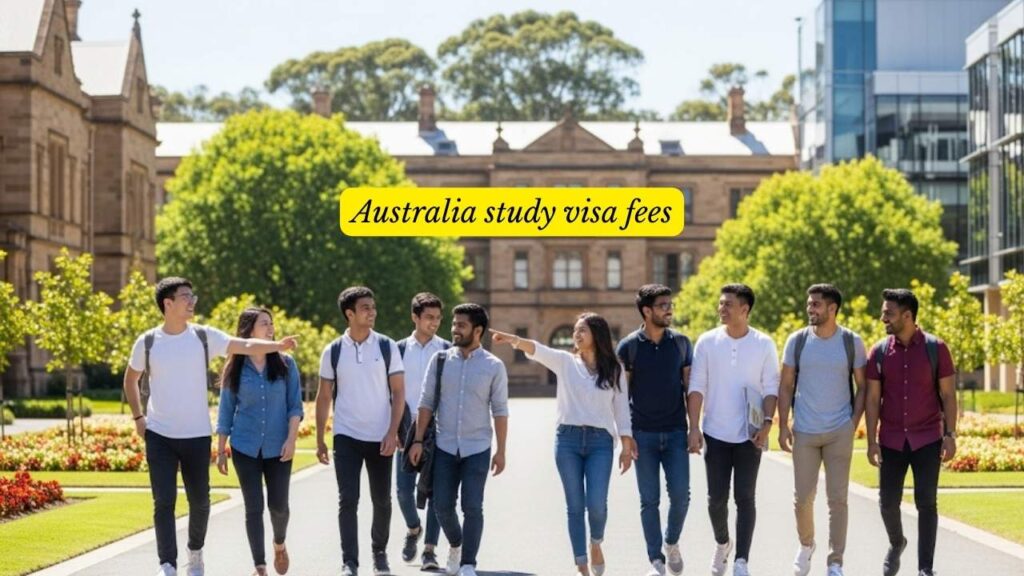Embarking on a study abroad journey is an exciting, life-changing decision, and for many, Australia stands out as a dream destination. With its world-class education system, vibrant culture, and stunning landscapes, it’s no wonder so many aspiring students set their sights on the Land Down Under. However, as of July 1, 2025, the cost of pursuing this dream has shifted, with the Australia study visa fees increasing to AUD 2,000 for primary applicants. This marks a significant change from the previous AUD 1,600, making Australia’s student visa one of the most expensive globally.

I’ve advised countless students over the years, and one common thread I’ve observed is the importance of being fully informed about every aspect of their overseas journey, especially the financial implications. This recent fee hike, while a new development, is a crucial piece of information to factor into your planning. My goal here is to provide you with a clear, comprehensive, and encouraging guide to understanding these changes and successfully navigating your path to studying in Australia.
Understanding the New Student Visa Fee: What You Need to Know
The Australian government, through its Department of Home Affairs, has implemented this increase as part of broader efforts to manage the international education sector sustainably and ensure the integrity of the visa program. The new fee of AUD 2,000 applies to primary student visa applicants (Subclass 500) from July 1, 2025. It’s worth noting that existing reduced fees for eligible Pacific Island and Timor-Leste citizens remain unchanged.
This move is also part of a larger strategy to generate revenue, with an estimated AUD 760 million expected over the next four years. While this increase might seem daunting, it’s essential to view it within the context of your overall investment in a world-class education. Australia is committed to maintaining its reputation for quality education, and these funds are intended to support improvements in visa processing and migration systems.
Australia Student Visa Fee Increase
| Key Fact | Detail/Statistic |
| New Visa Fee | AUD 2,000 for primary Student Visa (Subclass 500) applicants, effective July 1, 2025. Study Australia |
| Previous Fee | AUD 1,600 (increased in July 2024 from AUD 710). |
| Revenue Generation | Expected to generate AUD 760 million over four years. |
| Global Comparison | Australia’s student visa fees are now the highest among major English-speaking study destinations, surpassing the US (approx. USD 185) and Canada (approx. CAD 150). |
| Policy Aim | To manage the international education sector sustainably, strengthen program integrity, and ensure genuine students contribute to Australia’s economic growth. The PIE News |
The increase in Australia study visa fees to AUD 2,000 starting July 1, 2025, is a new reality that aspiring international students must consider. While it adds to the financial commitment, Australia’s reputation for high-quality education, vibrant student life, and promising post-study opportunities remains undiminished.
My advice to you is simple: be proactive. Start your research early, plan your finances meticulously, and prepare your visa application with utmost care and attention to detail. This investment is not just in a visa, but in an unparalleled educational experience and a globally recognized qualification that can open doors to a world of possibilities. Your Australian adventure is still very much within reach!
Beyond the Visa Fee: Comprehensive Financial Planning for Your Australian Dream
While the visa fee is a critical component, it’s just one piece of the financial puzzle. To successfully study in Australia, you’ll need to demonstrate sufficient funds to cover your tuition, living expenses, and health insurance. This comprehensive financial preparation is vital for your visa application and, more importantly, for a comfortable and stress-free experience once you arrive.
Tuition Fees: A Major Investment
Tuition fees in Australia vary significantly depending on your chosen course and institution. For undergraduate degrees, you might expect to pay anywhere from AUD 20,000 to AUD 45,000 per year, while postgraduate courses can range from AUD 22,000 to AUD 50,000 annually.6 Doctorate programs typically fall in the AUD 20,000 to AUD 40,000 range. It’s crucial to research the specific fees for your desired program and university well in advance.
Living Expenses: Your Daily Budget
The Department of Home Affairs requires international students to show proof of funds for living expenses. As of early 2025, this amount is AUD 29,710 for a single student for 12 months. This figure covers essentials like accommodation, food, transport, and personal expenses. However, depending on your lifestyle and the city you choose, your actual expenses could be higher.

Estimated Monthly Living Costs (AUD)
- Accommodation: AUD 800 – AUD 2,500 (depending on type: on-campus, shared, homestay, studio)
- Food & Groceries: AUD 65 – AUD 103 (weekly average)
- Transport: AUD 100 – AUD 200 (monthly public transport pass)
- Utilities (Electricity, Gas, Water, Internet, Mobile): AUD 270 – AUD 490
- Personal/Miscellaneous: AUD 80 – AUD 90
- Entertainment: AUD 100 – AUD 120
Cities like Sydney and Canberra tend to be more expensive, while regional areas or cities like Adelaide and Darwin might offer a more affordable lifestyle. I’ve seen many students successfully manage their budgets by opting for shared accommodation, cooking at home, and taking advantage of student discounts on public transport.
Overseas Student Health Cover (OSHC): A Mandatory Requirement
OSHC is mandatory for all international students in Australia and must cover the entire duration of your stay. The cost varies by provider and the length of your stay, but you can expect to pay around AUD 1,160.70 annually. This ensures you have access to medical and hospital care during your studies.
Key Requirements for Your Australia Student Visa
Beyond the financial aspects, there are several other critical requirements for your Australian student visa (Subclass 500).
- Confirmation of Enrolment (CoE): You must be enrolled in a course registered on the Commonwealth Register of Institutions and Courses for Overseas Students (CRICOS). Your university will issue your CoE once your admission is confirmed and you’ve paid your initial tuition deposit.
- Genuine Temporary Entrant (GTE) Requirement: This is a crucial aspect of your application. You must demonstrate that your intention is to genuinely stay in Australia temporarily for the purpose of studying and not for permanent residency. Your Statement of Purpose (SOP) plays a vital role here, showcasing your genuine academic goals and ties to your home country.
- English Language Proficiency: You’ll need to provide evidence of your English language skills, typically through tests like IELTS, PTE, or TOEFL. The required scores vary depending on your course and institution, but generally, an IELTS overall band score of 5.5 or higher is a common benchmark.
- Health and Character Requirements: You may need to undergo medical examinations and obtain police clearance certificates to meet these requirements.

Impact and Outlook: What the Fee Increase Means for Aspiring Students
While the fee increase might cause some initial concern, especially for students from price-sensitive markets, Australia remains a highly attractive study destination. The government’s emphasis on quality and integrity within the international education sector aims to ensure that those who come to study are genuinely committed to their academic pursuits.
The English Language Intensive Courses for Overseas Students (ELICOS) sector, which caters to students seeking to improve their English skills before commencing their main courses, has voiced some concerns about the impact of this and previous fee increases on short-term enrollments.16 However, for students pursuing full degrees, the AUD 400 increase in visa cost, while noticeable, is a relatively small addition to the overall investment in tuition and living expenses, which can range from AUD 55,000 to AUD 85,000 annually.
What You Can Do
- Start Saving Early: If Australia is your dream, begin saving and budgeting well in advance.
- Research Scholarships: Explore various scholarship opportunities offered by Australian universities, the Australian government, or your home country. These can significantly offset costs.
- Consider Regional Study: Regional universities and cities often have lower living costs, offering an excellent academic experience without the high price tag of major metropolitan centers.17
- Seek Expert Advice: Don’t hesitate to consult with education counsellors or migration agents who specialize in Australian student visas. Their expertise can be invaluable.
Post-Study Work Opportunities and Long-Term Prospects
Australia continues to offer attractive post-study work opportunities, which is a major draw for international students. The Temporary Graduate visa (subclass 485) allows eligible graduates to stay and work in Australia for a period after completing their studies.The length of stay depends on your qualification level, typically ranging from two to three years for Bachelor’s and Master’s degrees, and longer for research and doctoral degrees. For Indian nationals, specific concessions apply under the Australia-India Economic Cooperation and Trade Agreement (AI-ECTA), offering extended post-study work rights for certain qualifications.
Bridging the Gap: Navigating Irrelevant Skill Distances for Working Abroad
The Complete 2025 Guide to the USA Citizenship Process for Disability Exemptions
FAQ
Q1: What is the new Australia study visa fee starting July 1, 2025?
The new fee for the primary applicant of an Australia Student Visa (Subclass 500) is AUD 2,000, effective July 1, 2025.
Q2: Why did Australia increase the student visa fees?
The Australian government increased the fees to manage the international education sector sustainably, strengthen the integrity of the visa program, and generate revenue to support improvements in migration and visa processing systems.
Q3: Are there any exemptions to the increased visa fee?
Yes, eligible primary applicants from Pacific Island nations and Timor-Leste may still qualify for reduced visa charges.
Q4: Besides the visa fee, what other significant costs should I budget for when studying in Australia?
You should budget for tuition fees (ranging from AUD 20,000 to AUD 50,000+ annually), living expenses (officially AUD 29,710 for 12 months, but potentially higher depending on location and lifestyle), and Overseas Student Health Cover (OSHC), which costs around AUD 1,160.70 annually.23
Q5: How can I demonstrate that I am a Genuine Temporary Entrant (GTE) for the Australian student visa?
The GTE requirement assesses your genuine intention to stay in Australia temporarily for study. You can demonstrate this through a well-written Statement of Purpose (SOP) that outlines your academic goals, ties to your home country, and how the Australian qualification will benefit your future career.
Q6: Will the visa fee increase affect my post-study work visa options in Australia?
The increase in the student visa fee does not directly affect the eligibility or duration of the Temporary Graduate visa (subclass 485). However, broader immigration policies are continually reviewed, so it’s essential to stay updated on any changes to post-study work rights.
Q7: Where can I find the most accurate and up-to-date information on Australian student visa requirements?
The most authoritative source for information on Australian student visa requirements, fees, and policy changes is the official website of the Australian Department of Home Affairs and Study Australia.










